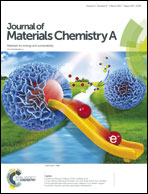In situ growth of α-Fe2O3 nanorod arrays on 3D carbon foam as an efficient binder-free electrode for highly sensitive and specific determination of nitrite†
Abstract
Long-term accumulation and overdose of nitrite ions have been proven to pose a great threat to the ecological environment and public health. Therefore, it is highly desirable to construct a novel architecture electrode for the accurate quantification of nitrite in a simple and inexpensive manner. Herein, a simple and cost-effective strategy is developed for the construction of a three-dimensional (3D) α-Fe2O3 nanorod arrays (NAs)/carbon foam (CF) architecture, in which CF is initially obtained from the direct carbonization of commercially available melamine foam and then α-Fe2O3 NAs are grown in situ on the underlying CF skeleton via a simple hydrothermal treatment and secondary pyrolysis. In the unique 3D architecture, α-Fe2O3 NAs provide abundant active sites for electrocatalytic reactions; meanwhile, CF features a large amount of interconnected channels to facilitate fast mass diffusion and electron transfer besides good electrical conductivity. Benefiting from these collective effects, the unique 3D architecture is innovatively exploited as a binder-free electrode for the determination of nitrite. As expected, the as-fabricated α-Fe2O3 NAs/CF sensor exhibits enhanced electrochemical performance towards the oxidation of nitrite in terms of higher catalytic peak current and reduced oxidation potential as compared with the binder-containing counterparts. Importantly, the as-fabricated sensor demonstrates excellent detection performance towards nitrite with a fast response time of approximately 3 s, a wide linear range from 0.5 μM to 1000 μM, a high sensitivity of 116.8 A mM−1 cm−2 and a low detection limit of 0.12 μM, which is dramatically lower than the maximum allowable level of nitrites (∼65 μM) in drinking water set by the World Health Organization (WHO). It is noteworthy that the current electrochemical sensor has a specific recognition capability towards nitrite ions, and hardly interfered with by the coexisting species in natural waters. Additionally, the proposed sensor can still maintain excellent reproducibility and stability after 30 days of storage under ambient conditions, supported by the negligible decrease in electrocatalytic activity. Furthermore, the α-Fe2O3 NAs/CF electrode also shows prospective applications in the determination of nitrite ions in real samples, as illustrated by satisfactory recoveries in tap water and lake water.



 Please wait while we load your content...
Please wait while we load your content...